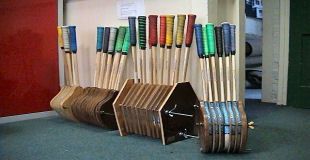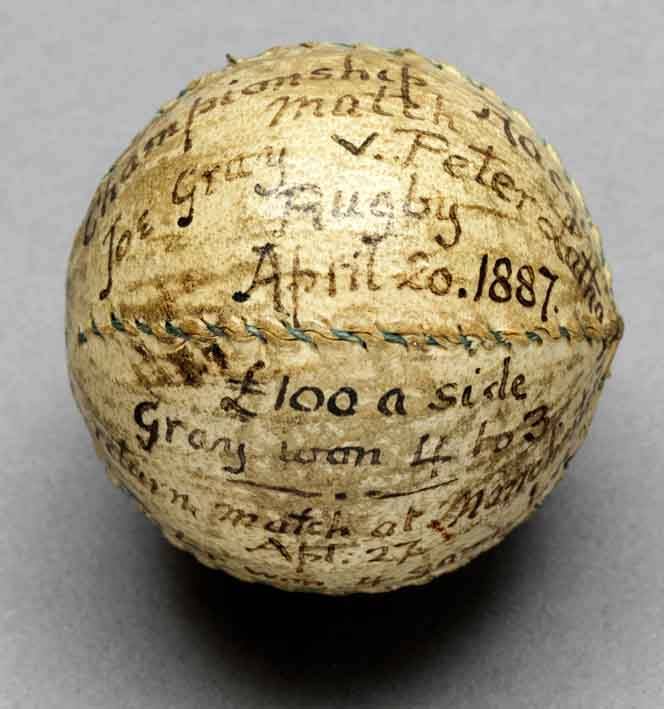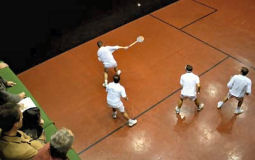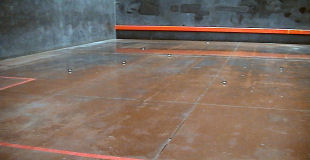The Evolution of Rackets
From debtor's prisons to the top schools.
Rackets from the 18th Centaury
In the 18th Century, Rackets was played on the walls of the two main debtor's prisons
In its earliest form during the 18th Century, Rackets was played in the open on the walls of the yards of the two main debtor's prisons, the King's Bench and the Fleet. Gentlemen, imprisoned until they could find the wherewithal to repay their creditors, amused themselves with many different activities around the prison yard. These included skittles, fives, which was played both with the hand and a bat (as at Westminster School), and some brought tennis racquets with them and improvised against any convenient wall, sometimes with no side walls and always without a back wall.


There is mention of Rackets at the Fleet in a poem of 1749 and in John Howard's report on the state of prisons in England and Wales published in 1780. It is not until the early 1800s that Rackets becomes part of life outside the prisons. In his Book of Sports and Mirror of Life published by Pierce Egan in 1832, there is a long description of Rackets mentioning several open rackets courts other than the King's Bench and the Fleet. One of these was at the Belvedere Tavern, Pentonville, where most of the Open Court Championships were played. Others were to be found elsewhere in London, again at public houses, at the Eagle Tavern on the City Road, The White Bear Kennington, the White Conduit House, and the Rosemary Branch, Peckham.”
Dickens mentions Rackets in the Pickwick Papers, as Mr Pickwick had the misfortune to be incarcerated in the Fleet. From Dickens' description the Fleet court appears to have had a front wall and one sidewall similar to a Jai Alai fronton
There are further records of courts at Bristol, Bath, Birmingham and Belfast. Egan states that if a gentleman sought a game at a tavern he would have to mix with those not of the highest rank in society. Implicit in this observation is that the debtors prison may have had a higher class of player (in both meanings of the word), and mention is made of a Major Campbell who was the best player in the King's Bench through having been incarcerated there for fourteen years. Spectators as well as prison visitors often came to watch matches in the prisons. Dickens mentions Rackets in the Pickwick Papers, as Mr Pickwick had the misfortune to be incarcerated in the Fleet. From Dickens' description the Fleet court appears to have had a front wall and one sidewall similar to a Jai Alai fronton. In 1814 there were four courts at the King's Bench and six Racket masters to look after them. Early courts outside the prisons had a front wall only, about 40 feet wide and 45 ft high.
Outside prisons and taverns, Harrow was the first school at which Rackets was played, probably from the early 1820s when the schoolyard was enlarged. When the first Lawn Tennis Championships were played at Wimbledon later in the century, Old Harrovian Rackets player Spencer Gore would win the singles.
Rackets in the 19th Century
In the middle of the 19th Century, Rackets played in covered courts began to predominate.
The MCC built a court in 1844 next to the old Tennis court, and the old Princes Club opened in 1853 with several courts as well as two Tennis courts. The main competition court at Princes set the standard dimensions for most closed courts built from then up to the present day, being 60' long by 30' wide. Before this on the open courts, doubles was played on a court of 80' x 40' with two players playing up at the front of the court and two at the back.
Furthermore, and again about the middle of the 19th century, the growing popularity of the indoor game caused Rackets at the open courts attached to public houses to fall into desuetude. Rackets increasingly developed as a game for the wealthy. Although Lord West built a court at Buckhurst Park in Sussex in the 1850s and The Earl of Eglinton and Winton built one at Eglinton Castle, his home in Scotland, Rackets did not take off as a private country house game to the same extent as Tennis did later in the century.


Both Oxford and Cambridge universities had courts by 1855, the date of the first Varsity match. There were courts built at Torquay in 1859 and the first covered court at Harrow school, built in 1865. This has recently been reconstructed to create the Prenn Hue Williams Court.
Devonshire Park at Eastbourne included a Rackets court built in 1870 as part of its general recreational facilities. Between 1870 and 1890, courts were built at the new Princes Club, Manchester, Liverpool and in 1888 the courts at The Queen's Club were opened.